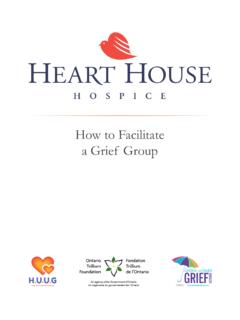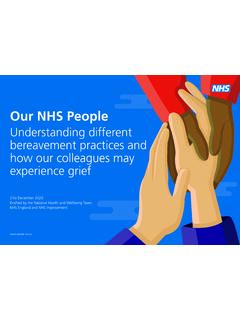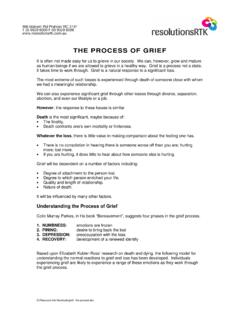Transcription of Grief and bereavement theories - Hospice Whispers
1 44june 16 :: vol 24 no 41 :: 2010 NURSING STANDARDDEATH IS A SITUATION that is frequentlyencountered by nurses and other healthcareprofessionals in the course of their work . It isimportant that nurses have a good understanding of the reactions and responses to Grief andbereavement so that they are in a better position to support patients, family members and relativesduring the grieving is a natural human response to separation, bereavement or loss, in particular the loss of a lovedone. The terms Grief , mourning and bereavementare often used interchangeably, however they havedifferent meanings. Grief describes an individual spersonal response to loss and has emotional,physical, behavioural, cognitive, social andspiritual dimensions (Greenstreet 2004). Mourningis the outward and active expression of that Grief . It is through the process of mourning that Grief is resolved. bereavement refers to the period afterloss during which Grief and mourning occur.
2 It is the state of having experienced a loss. Bereavementis a form of depression, which usually resolvesspontaneously over time. The person who isbereaved may experience anxiety, insomnia, inertia, hyperactivity or a feeling of , mourning and bereavement may beaffected by personality, culture, religion, the natureof the relationship with the deceased person and theway in which he or she died. Stroebe et al(1993)defined bereavement as a state of loss, triggering agrief reaction that manifests in a set of behavioursknown as mourning. theories and frameworksMany theories or models of Grief have commonthemes or stages (Lindemann 1944, K bler-Ross1969, Parkes 1975, Bowlby 1980, Worden 1991).Diagrammatic representations such as the griefwheel are often used to describe the process andstages involved in Grief , suggesting that it is rarely a static process. However, other models, forexample the dual process model of coping withbereavement (Stroebe and Schut 1999), provide a more flexible approach to the interpretation andmanagement of Grief .
3 It describes how a bereavedperson copes with the experience of loss ineveryday life, along with other lifestyle changesthat develop as a result of that loss. The dualprocess model is based on the principle that whenpeople are grieving, the manner of coping is a two-way process: The person moves betweengrieving and trying to come to terms with the loss (Dunne 2004).Freud (1961) viewed Grief as a solitary process,whereby mourners withdrew from the world sothat detachment from the deceased could be agradual process. The psychological function of griefwas thought to release the individual from his or herbond with the deceased. This was achieved bylooking back at the past and reliving memories ofthe deceased person. Detaching from the deceasedinvolved working through the loss so that the griefcould be overcome. This was often termed griefwork . This focus on letting go of, or detachingfrom, the deceased to accommodate Grief is stilldebated among theorists (Payne et al1999).
4 Freud s(1961) theories about Grief were based on clinicalexperience with people who were his understanding of Grief and loss may be limited to this specific group and may not beapplicable to the general population. However,Freud s (1961) ideas about Grief and, moreimportantly, the need to confront Grief to allowGrief and bereavement theoriesBuglass E(2010) Grief and bereavement theories . Nursing Standard. 24, 41, 44-47. Date of acceptance: January 4 &scienceend of life careSummaryThis article explores the main theories of Grief and bereavement . It isimportant that nurses have a good knowledge and understanding ofthe processes and stages involved so that they can supportindividuals who are bereaved. The terms Grief , mourning andbereavement are defined and the unique experience of loss isemphasised, acknowledging the importance of person-centred Buglass, Macmillan head and neck clinical nurse specialist,Maxillofacial Unit, Queen Elizabeth Hospital, Birmingham.
5 Email: KeywordsBereavement, end of life care, Grief , mourning, theoriesThese keywords are based on subject headings from the BritishNursing Index. All articles are subject to external double-blind peerreview and checked for plagiarism using automated software. Forauthor and research article guidelines visit the Nursing Standardhome page at For related articlesvisit our online archive and search using the w41_A&S 14/06/2010 10:56 Page 44detachment have remained a feature of subsequenttheory and (1944) identified parameters for normal and pathological Grief , such asduration, intensity and changes in socialfunctioning. However, many of the pathologicalfactors identified are now known to be relativelycommon and are accepted as normal reactionsto Grief . Based on his clinical experience focusingon people who have been bereaved as a result ofdisasters, Lindemann (1944) developed a theoryof Grief with five distinct phases, including: 4 Somatic disturbance, for example, tightness in the throat, shortness of breath or with the image of the , for example, reviewing behaviour thatoccurred before the death for evidence ofnegligence and/or of hostility or in carrying out everyday (1944) suggested that Grief work , thepsychological process of coping with a significantloss, required the bereaved person to becomeemotionally detached from the deceased personand adapt to a new environment in which thedeceased was not included.
6 Subsequent studieshave confirmed these findings (Parkes 1964,Bowlby 1980).K bler-Ross (1969) identified five stages of Grief , model was devised as a means ofunderstanding and coping with dying and wasbased on K bler-Ross work as a psychiatrist withdying patients. Although the model has been usedwidely it has also received some criticism. Onelimitation of stage or phase models is that theyfollow a fairly set pattern whereas, in reality the stages or phases often overlap or occur non-sequentially. Corr (1993) stated that K bler-Ross (1969) work was organised aroundclinical impressions, not empirical data. Corr(1993) argued that the five stages resemble defencemechanisms and are too linear, rigid and passive tobe used in the complex processes of Grief andbereavement. In addition, K bler-Ross (1969)model of Grief in the individual with life-limitingillness is often misinterpreted and applied tobereavement.
7 While the person who is dying maygrieve for the loss of his or her future and ashortened lifespan, the bereaved person mournsthe death of the deceased and the life shared withthat s (1973) theory of attachmentemphasises the importance of humanattachments and bonds that are developed earlyin life. Grief evolves through a sequence of fouroverlapping, flexible phases. These and provides an explanation for the commonhuman need to form strong affectional bondswith other people and the emotional distress orreactions caused by the involuntary severing ofthese bonds and loss of attachments. Bowlby(1973) relied on childhood experiences toexplain bereavement reactions in adulthood. He viewed attachment as a mutual relationship,occurring as a result of long-term interactions,which starts in infancy between a child and his or her parents and later between adults. Thesebonds and attachments remain activethroughout the life cycle.
8 In psychoanalytic theory, Grief work relates to the struggle to sever ties and detach energyinvested in the deceased person, whereasattachment theory is characterised by a responsethat many individuals experience when strongaffectional bonds are disrupted, for exampleattempting to regain a feeling of closeness (Stroebeet al2004). When death occurs, that closenesscannot be regained leading to protest and despair. Stroebe (1992) discussed some of theshortcomings associated with the Grief workhypothesis, such as the notion that one has toconfront the experience of bereavement to come to terms with death and avoid detrimentalhealth consequences, such as sleep disturbance,loss of appetite, absent mindedness and social (1998) theory of grieving is similar tothat described by Bowlby (1973) and identifiesfour phases of bereavement . These are:4 Shock or and and is described as the transition of the bereavedperson from incomprehension and denial,through a distressed state of confrontation withjune 16 :: vol 24 no 41 :: 2010 45 NURSING STANDARDp44-47 w41_A&S 14/06/2010 10:56 Page 45reality and finally to some form of resolution (Parkes 1998).
9 It was noted that these phases werenot always linear, but could be experienced severaltimes as a result of reminders of the loss or a triggersuch as an anniversary. Parkes (1996) suggestedthat Grief is not a state, but a process that does notinvolve symptoms that begin after a death andthen fade away, but rather a succession of phasesthat merge into and replace each other. Parkes(1986) focused on the emotional and physicalresponses to a death, emphasising the prevalenceof anxiety, searching behaviour, anger and guilt,and the necessity of working through thosefeelings to adapt to the (1991) adopts a different approach toloss by setting tasks that have to be workedthrough if Grief is to be resolved. In Worden s(1991) model the emphasis moves from passivephases of Grief to active tasks of mourning. Thesetasks include:4 Task one to accept the reality of two to work through and experience thepain of three to adjust to an environmentwithout the deceased person.
10 The bereavedperson must embrace new roles and adjust to the changing dynamics of his or herenvironment. Often the full extent of what this involves, and what has been lost, is not realised until some time after the four to withdraw emotionally from orrelocate the deceased and move on. Relocationrequires that the bereaved person forms anongoing relationship with his or her memoriesof the deceased in such a way that he or she is able to continue with his or her and disadvantages of stageand phase modelsStroebeet al(2004) suggested that the stage or phase models are more about the dynamicprocess of coping. The grieving person worksthrough his or her Grief actively, rather thanexperiencing it in a passive way, which representsthe reality for most individuals who the shift in emphasis is from passive to active in these models, in some respects thegrieving process draws on attachment theory,recognising the way in which people make strong affectional bonds with each other andacknowledging the emotional reactions that maytake place when these bonds are broken, such assadness, helplessness, loneliness, numbness andself-reproach.




